Many of you know Molly-Max recently gave us another good fright when he went completely lame in his front left hoof on September 20.
We spent the first week treating him on our own until I’d done enough research and worried myself into a tizzy that something more might be wrong with him.
We’d had an appointment already scheduled for October 1 with our equine vet for an annual check-in for both Molly-Max and Dominic, but on September 27 I was ringing the vet and her husband to see if they could make an emergency visit to the farm (they bill it as emergency when it’s after hours or on weekends) so she could get a good look at him herself and give us her expert take.
They made their way over and fortunately, she quickly deemed he more than likely had an abscess in the hoof—something we’ve dealt with before and has always remedied within a week or two.
During previous visits we’d discussed x-rays of his hooves so we could get a factual look at what we were really dealing with.
Back then, she wanted us to save our money and focus solely on getting Molly-Max back to his correct weight (they both were severely malnourished from worms when they first got here), heal his hooves the best we could through regular hoof trimmings, get his nutrition back in check so that his overall health would improve, and to see how we did with all of that plus sunshine and movement in the pasture and good quality hay and of course, a whole lot of love.
This time around, Dr. Cornell brought the x-ray machine in their SUV-turned-mobile-equine-clinic. Her husband, Mark, who accompanies her to all her visits to assist with patients, had Chris and I suit up with radiation suits for our own protection while he prepped the machine. From the SUV (where their two dogs hang out during appointments) he unloaded a folding table and a giant black utility suitcase and set up the table at the backside of the Big Barn and unfolded the suitcase on top.
Dr. Cornell set up the laptop, plugged in the $75,000 handheld x-ray machine, and got out two wooden blocks. She pulled a needle full of sedative for Molly-Max and had me hold his head up, had Chris steady him from behind, had Mark hang onto his harness and lead, and gave him the sedative in the large neck muscle that runs down the side left side of the front of his neck.
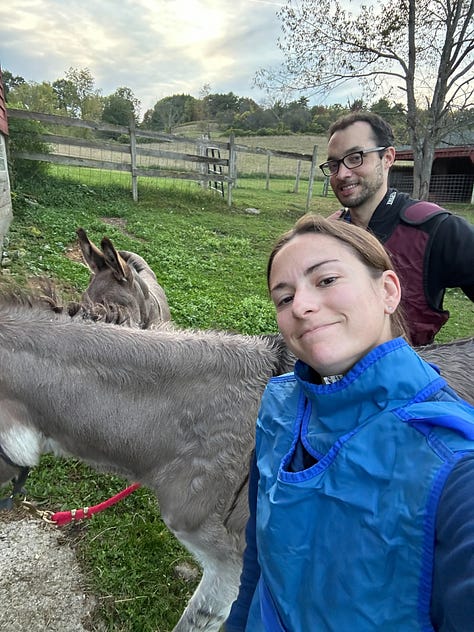
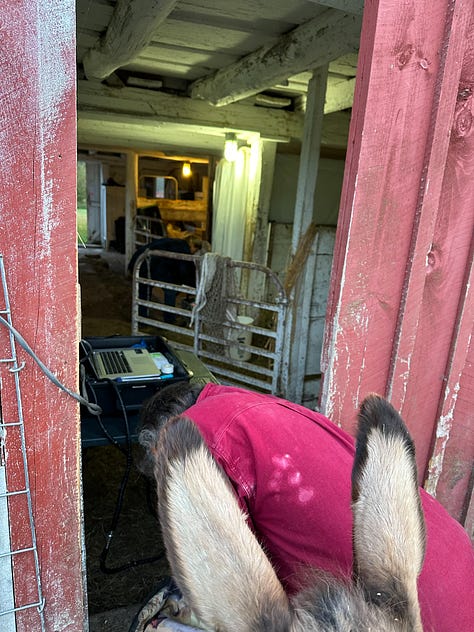
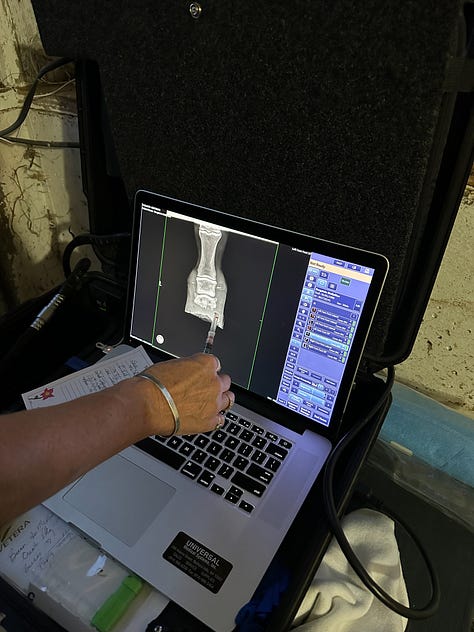
When equines are sedated they still stand and they’re still awake, it just dulls their ability to move with all their own force and makes them look a little bit drunk and wobbly.
The sedative kicked in quickly and Mark placed MM’s right hoof up on one of the blocks while Dr. Cornell placed the x-ray plate in various positions behind and to the side of his hoof and then used the portable machine to take the images which immediately loaded onto to the laptop in the utility suitcase.
The right hoof was of course easier than the left because MM was hardly putting any weight on his left hoof during this time. The four of us working together to hold up drunken-Molly-Max, steady his aching foot on the block, and Dr. Cornell getting her images was quite the feat, but of course, we made it work.
The sedative wears off in about an hour so Mark and Chris helped walk MM back into the run-in shed so that he could either lay down or just hang out safely in there until he was feeling back to himself again. Dr. Cornell said it was probably a nice little break for him to be somewhat numb to his pain for a little while.
By this point the sun was setting, a group of about 10 deer were gathered on the hill headed down to the pond, and the Big Barn’s lights came on for the evening.
We huddled around the laptop to get a good look at what we were dealing with.
Fortunately, all my worries about a rotated or slipped coffin bone were not present on the x-rays. With how slowly Maxy had been making progress with our regular treatment for an abscess, this is what started to send me into a fit, but the x-rays confirmed no reason to worry about that.
I asked Dr. Cornell, “How do the images compare to what you expected his hooves to look like?” and she said they were “exactly as bad” as she’d expected.
In order to understand how Maxy got here, let me give you a little bit of context about donkeys.
Donkeys are desert animals. In their habitat they generally spend their days walking miles and miles in search of food and water, so they move a lot (natural hoof care!), eat a little, and generally eat very little lush green grass or plants filled with sugar.
As part of the equine family, this is similar for the most part to horses in terms of their diet and care.
So donkeys who get to enjoy life beyond the desert in the lush green rolling grassy hills like we have here have one key problem: too much access to grass causes laminitis.
It helps to think of it like the same way that too much candy rots your teeth—too much lush green grass provides too much sugar for a donkey’s diet which causes inflammation in the hooves.
Laminitis (or founder) is inflammation of the laminae of the foot—the soft tissue structures that attach the coffin bone of the foot to the hoof wall. The inflammation and damage to the laminae causes extreme pain and leads to instability of the coffin bone in the hoof.
Generally when a donkey or horse develops laminitis, it doesn’t ever necessarily go away, but it can be managed.
In Molly-Max’s case, he and Dominic spent many years living on long summers of green grass and infrequent hoof trimmings. There’s no fault or blame whatsoever in that—it’s just the way it is—and so today, as a roughly 25-year-old donkey (we don’t know his exact age but 25 is probably about right) his hooves tell the story of the way he lived his life up until 2022 when we started making significant changes for his hoof health and overall wellbeing.
So now I want to show you the x-rays and give you a little bit of info as to what you’re looking at.
In order to do that I thought I’d share with you the x-rays of what a normal donkey hoof should look like.
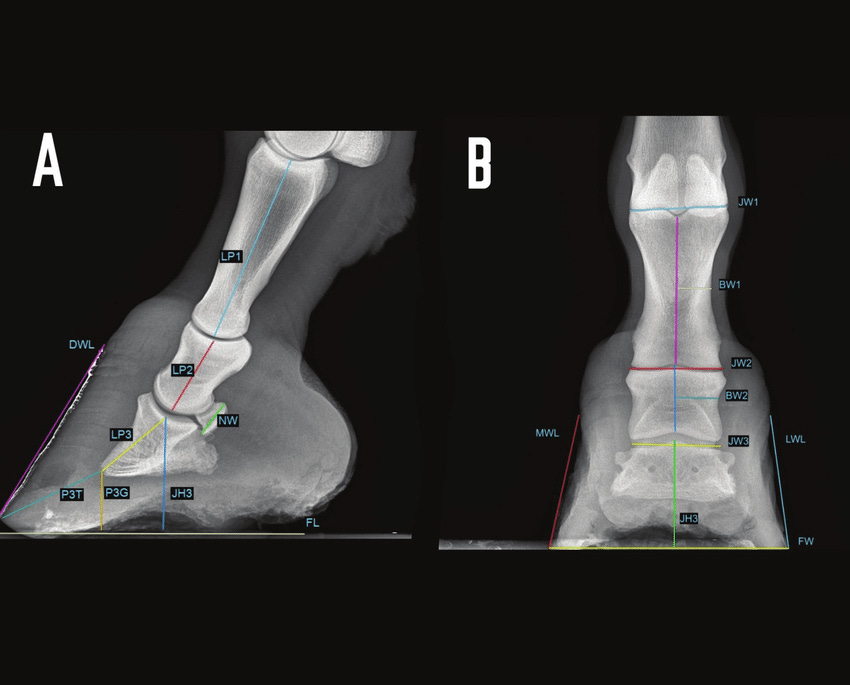
Now that you had a chance to take a look at that and see what “right” looks like, here’s a look at our old boy Molly-Max:
Left Hoof—this is the current hoof that has the abscess:
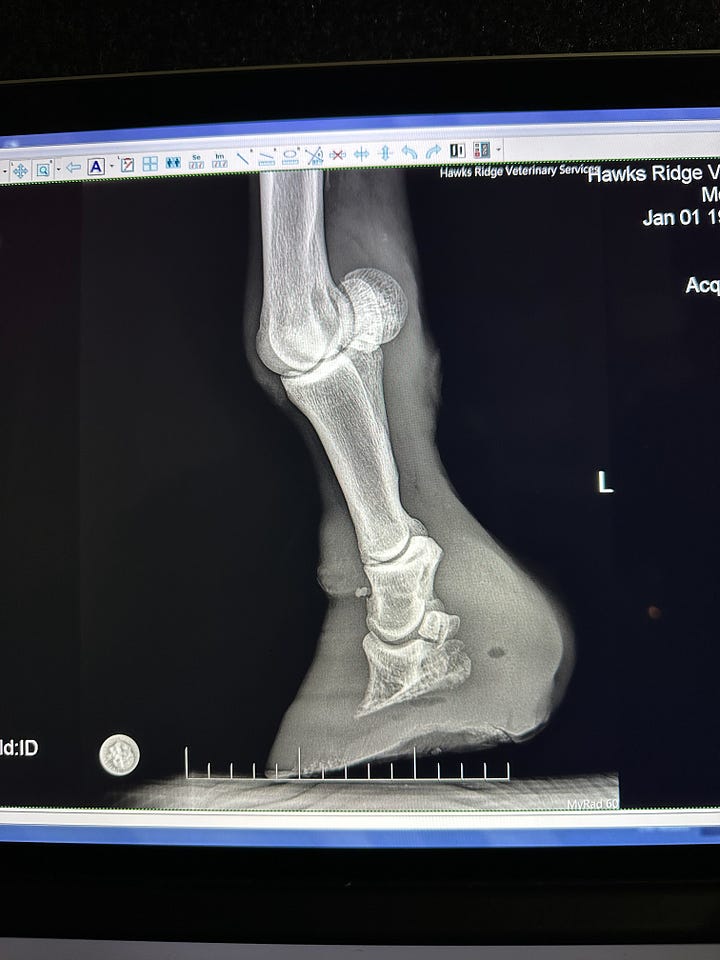
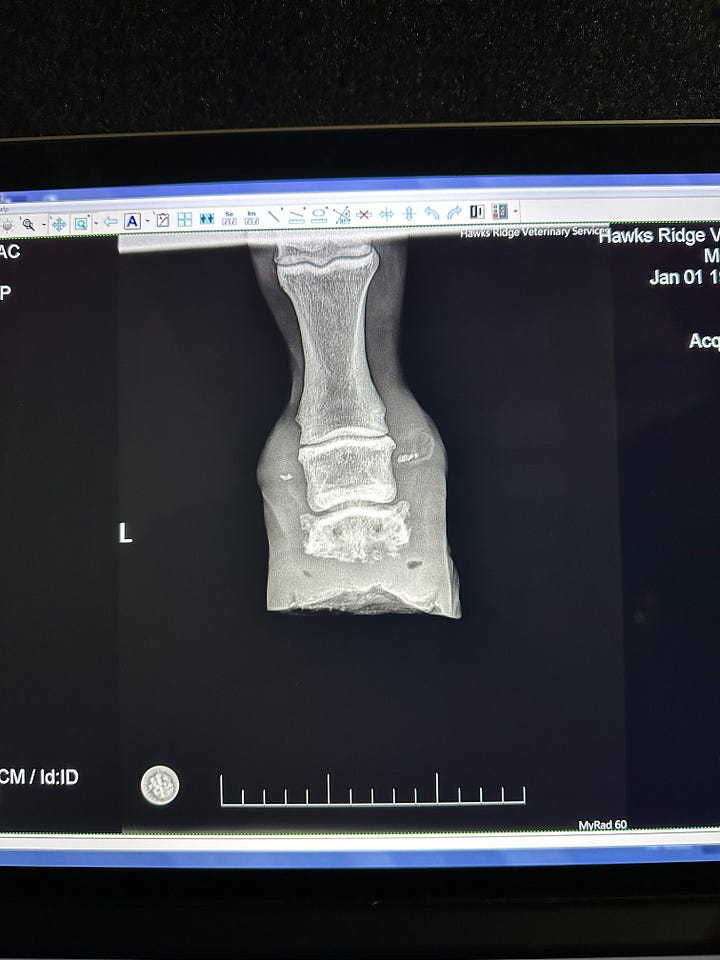
Here’s some of the issues with the left hoof: the black spot you see towards the back of the hoof in the side view and on the right, outer part of the hoof in the back view is the abscess—on the back view you can also see up towards the top of the hoof where it meets the ankle on the right side of the image the light white lines—that is essentially like gas in the hoof, signaling the infection is at the top of the hoof and will more than likely “blow out” of the top of the hoof when it ruptures. This is the most painful type of abscess for an equine because of the pressure it causes in the hoof.
Thankfully while Mark was walking Molly-Max around before we did the x-rays, it did rupture up out of the top of his hoof which is a very good sign—it means healing can begin and it relieves a lot of the pressure for Maxy. And yes, it was disgusting.
In the side view you’ll notice how the coffin bone is at the wrong angle compared to the outer wall of the front of the hoof, and you may even notice the bone chip in the bone above the coffin bone. These are all signs of the deterioration of his left hoof over the years. In the rear image you can see on the right side of the coffin bone that mark that looks like a spot or a hole—that is bone deterioration.
Right Hoof—brace yourself for this one:

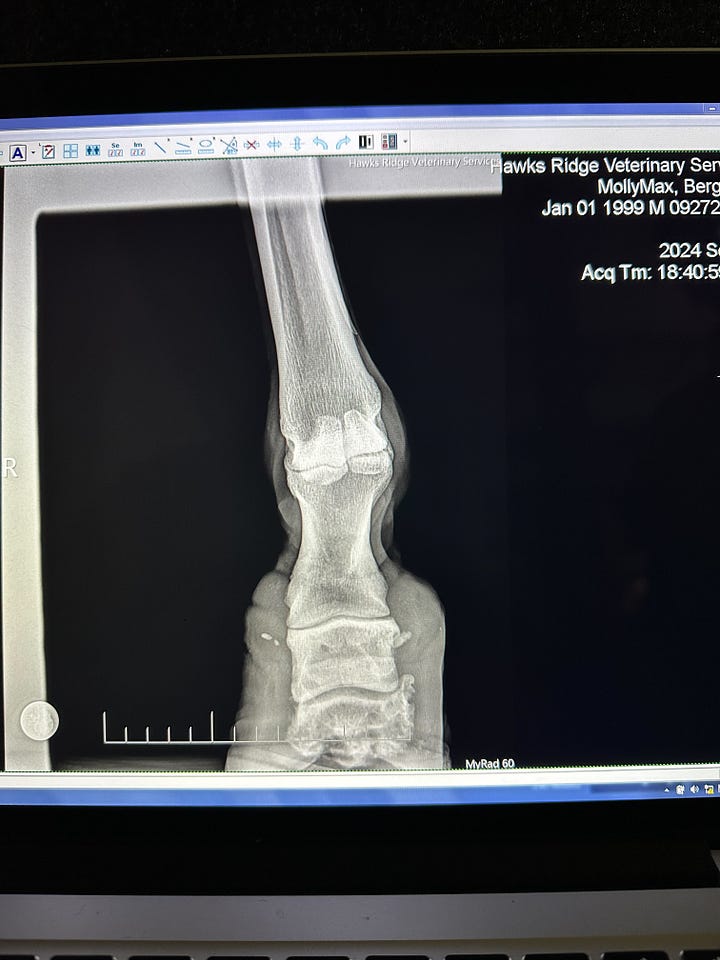
Now, some of this is due to the sedation and the way Molly-Max was standing on the block and just the nature of trying to take x-rays of a drunken donkey. But you can see that his right hoof is far worse than the left, both in the overall makeup of the hoof and bone structure (notice how the leg bones are bending almost backward) and the coffin bone is deteriorated, misshapen, and completely out of alignment with the front of the hoof.
Dr. Cornell remarked that while his left hoof is feeling as bad as it is, his right hoof is taking a beating, too, just because it’s likely quite painful to have all the weight on his worse hoof while the other one is healing.
We wondered if we were doing something wrong with his care that caused this most recent abscess but she assured us they’re often a result of the poor structure of his hooves and develop due to changes within the hoof. She recommended we have his hooves trimmed more often than 8-12 weeks and we’ve shown our farrier Shawn the x-rays and he’ll be coming to work on Maxy more often for the next few trimmings.
So now, if your stomach is in knots and you feel absolutely horrible for Molly-Max and this is hard to read…know that Dr. Cornell and Mark think Molly-Max is a miracle, a fighter, and that he’s improved far beyond their expectations from the very first time they saw him in March 2022.
They said directly to Molly-Max, “there’s no way you’d still be here if it wasn’t for these two caring so much about you.” That makes me teary to type that and it helps a ton that they’re so proud of how far we’ve all come. It has certainly been a team effort!
As for the prognosis and what’s next, they expect Molly-Max will make a full recovery from the abscess and as of Saturday night he’s doing far better than he was when they were here eight days ago.
Going forward, we asked Dr. Cornell how long she thinks Molly-Max can continue like this, understanding now what his hooves look like from the x-rays. Obviously there’s no certainty, but she said that donkeys are so resilient and that she’s been surprised by so many she’s treated over the years—that Molly-Max could easily have another good 5-10 years, even given the shape his hooves are in.
She cleared both Molly-Max and Dominic for transport if/when we ever find another farm we’d like to move to, and said he’d do just fine as long as he wasn’t recovering from a recent abscess and that we took a few precautions to make him comfortable for the journey. Should we ever arrive at that reality, we’d hire professional transport to move the donkeys and have chatted with our horse boarding neighbors about potential transporters.
In the meantime, the focus is all on healing this current abscess and helping Molly-Max get back to his normal day-to-day.
He’s got two days left of antibiotics and we’ll continue giving him some supplements to help restore the good gut bacteria after being on a 14-day round of meds. Additionally, Dr. Cornell recommended we supplement with Devil’s Claw every day—a natural anti-inflammatory to help with pain management. Finally, we’ve been putting a fresh poultice wrap on every day, which seems to be helping the most out of everything we’re doing.
A poultice is this white cotton pad with a drawing agent in it. You cut the pad to the size of the hoof and then get it wet with hot water, press it to the hoof, and wrap the hoof. We’re putting one pad on the bottom of the hoof and another along the top where the abscess blew out and then changing it daily. It’s absolutely disgusting, it smells so horrible it’s making me almost gag just to type about it, and it’s working like a charm—Dr. Cornell has us doing this until the poultice pads come out clear.
So that’s the long and short of Molly-Max’s current situation and long-term outlook. Knowing how much y’all love him like we do—and how much y’all love learning like we do—I thought you might like to hear all the details about his status and his ongoing care.
Of course, through all of this he’s been incredibly sweet and he’s eating well, drinking lots of water, keeping us busy with all his poop and his demeanor is unchanged. Donkeys really are the most resilient animals I’ve come across, and Miracle Maxy is as stoic as they come.
We’ll take good care of him and we’re hoping he’s back to his version of 100% again in just a few days!
Curious to know if you learned something today, if you have any questions, or would like to leave us a note about today’s Farm Note! Go on ahead!
Going to be wearing this athliesure outfit on repeat all season long:
This oversized long-sleeved tee I have in three colors.
This pair of buttery soft full length high-rise leggings with pockets
This long puffer vest for cooler mornings
*Note: Not all, but most of these links are affiliate links. That’s no matter to you, as it costs you nothing. However, if you make a purchase, we -may- receive a teeny weeny commission.






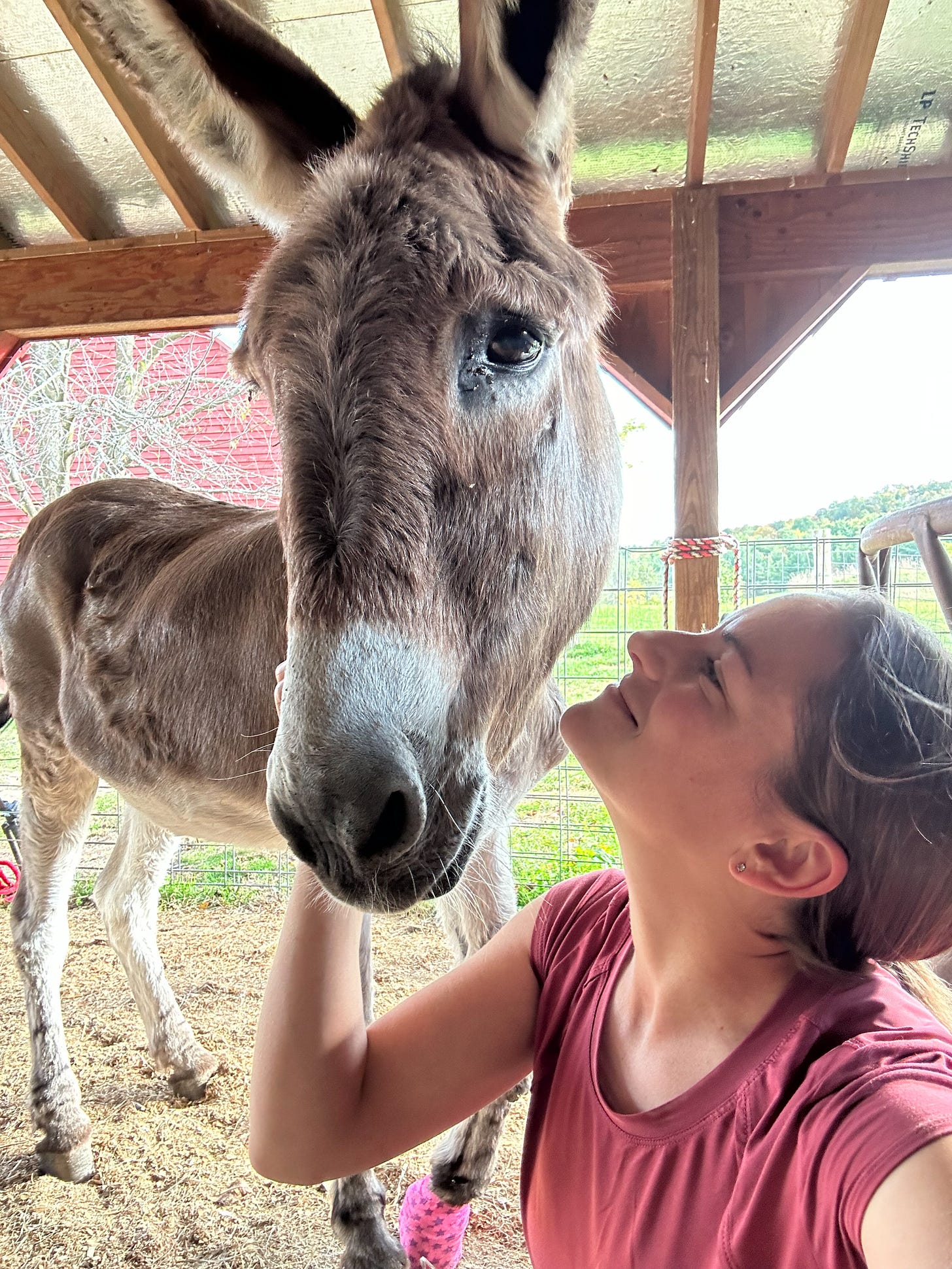


See, I started following you because of an infamous cat you adopted way back when (may he rest easy now) and here I am, years later, almost in tears about a donkey I've never met.
I'm a born and bred city girl, have only seen horses and never ridden one, but am now in love with Molly-Max and his little brother.
Seeing his x-rays and the comments from his vet make me very happy for you all.
I'm with Ania - teary eyed over this. I have always loved donkey's even as a city girl. Got to ride one on a trip to my mom's farm in Malta (dry conditions). then saw them around the racetracks I'd visit with my dad. I'd love a donkey but thanks to you I feel like Miracle Max is ours. That right hoof (and my bout of plantar facisits) has me wondering if there's a cast or boot to help adjust the bones? It really was jarring to see and looks so painful. Thank you for giving them both the absolute best care. Share an Amazon wish list if you need treats, or supplies, or treats.